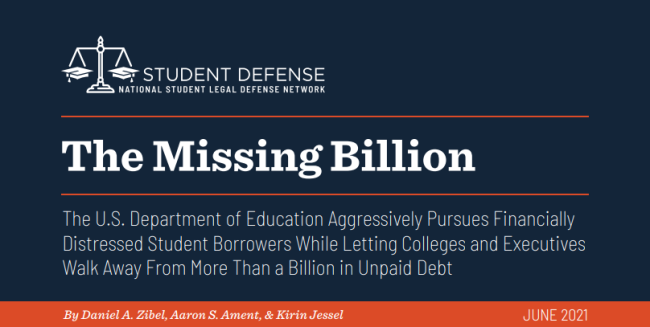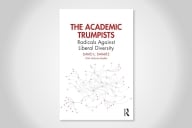You have /5 articles left.
Sign up for a free account or log in.

Student Defense's latest report, "The Missing Billion"
Screenshot/Student Defense
Nearly 1,300 institutions of higher education owe around $1.2 billion in debt to the Department of Education. Even so, the department more aggressively pursues debt held by student loan borrowers, according to a recent report by the National Student Legal Defense Network. The findings align with what experts have experienced in navigating the student loan system, but others argue that the report lacks a complete picture of the department’s collection efforts.
Student Defense filed a Freedom of Information Act request with the department in February for a complete listing of all institutions with any financial liability or unpaid obligation that remains unpaid, regardless of whether they’re still participating in Title IV programs. They also requested the amount of those liabilities and the date they were assessed.
About $574 million of the outstanding liabilities is from 2018 or earlier, with some debt listed as more than 10 years old. Around $218 million has presumably been lost due to a five-year statute of limitations on the department’s authority to collect debts, according to the report.
“I think we didn't expect to see a number over a billion dollars,” said Daniel Zibel, vice president and chief counsel at Student Defense, and one of the authors of the report. “If you look at the chart, there are some pretty old ones there. It's surprising to see how the department seems to be just letting these things pass.”
It’s unclear what exactly the debts owed by individual institutions are -- that wasn’t a part of the information that Student Defense received from the department, said Zibel. They could be related to audit findings, closed-school discharges, fines, improper drawdowns from Title IV funds or borrower-defense claims.
Of the 1,300 institutions listed in the report, only about 200 are still participating in Title IV programs. The vast majority of those listed are for-profit institutions, and the institution with the largest outstanding debt is the now-closed Vatterott College, which owes the department over $244 million.
Several states are listed as well: Arizona, Florida and West Virginia collectively owe the department around $885,000. And a few nonprofit institutions are also listed as having outstanding liabilities, including Coastal Carolina University, the University of Southern California, the University of Alabama at Birmingham, the University of North Carolina at Charlotte and the University of Illinois Chicago.
Inside Higher Ed reached out to these universities for comment -- only the University of Illinois Chicago and Coastal Carolina University responded.
“In August 2017, during the ordinary course of a financial aid audit performed by the Department of Education for the academic years of 2014-15 and 2015-16, the liability was identified,” a spokesperson for Coastal Carolina said. “CCU paid the liability on Sept. 22, 2017, nearly five months prior to the date listed in the report.”
The University of Illinois Chicago submitted a proposal to the department in 2018 to resolve its audit findings over a five-year period. But if the department determines that UIC hasn’t abided by its commitments, it may issue a redetermination to recover the $1.2 million that the university owes, according to a letter sent to UIC by the department.
Zibel said the Student Defense analysis was based on exactly what it received from the FOIA request, and any errors in the data are the fault of the department.
A spokesperson for the department didn’t comment on the possibility of errors in its data but said it “is committed to improving our policies and practices to better hold institutions accountable for their actions, and to provide borrowers with fair and streamlined access to the benefits to which they are entitled.”
In addition to describing the debts owed to the department by institutions, the report highlights several instances in which the department has used aggressive collection tactics to receive money owed by student loan borrowers. It discusses the case of a woman named Ronishia, who filed for bankruptcy protection in 2019. The report says the department “steadfastly opposed any discharge of her debt using an array of litigation tools” and then took the matter to trial in March.
“While the department aggressively attempts to collect from borrowers, institutions and their owners and executives walked away from more than a billion dollars owed to taxpayers,” the report said.
But this creates a false dichotomy, said Nicholas Kent, senior vice president of policy and regulatory affairs at Career Education Colleges and Universities -- the organization that represents for-profit colleges -- giving the impression that the department can only pursue debts held by institutions or individuals but not both.
“As previous department employees, the authors should recognize that the federal government has a legal obligation to the taxpayer to recoup overdue debts from both borrowers and institutions and, in fact, does so regularly,” Kent said. “Unfortunately, in relying upon cherry-picked data, the report only serves to misinform the public and advances a false narrative that institutions are let off the hook at the expense of struggling students.”
The report doesn’t provide much insight into how much the department pursues debt collections from institutions, except for a few specific references to how it hasn’t -- by not collecting a small debt from Ashford University, failing to use letters of credit posted by Fortis College to satisfy the institution’s liabilities and recertifying institutions for continued participation in student aid programs despite owing them debt.
However, the report appears to be on par with what Adam Minsky, a lawyer who specializes in student loan law, has seen during his time helping student borrowers.
“I know the department, as a general rule, has historically been pretty aggressive when collecting from students on past-due debts,” Minsky said. “I'm also aware that historically, they have not shown the same level of concern towards institutions. That's why a lot of predatory schools have been allowed to stay in business for some time before there's a crackdown on improper practices.”
Over all, Zibel hopes the report encourages the department to re-examine how it holds institutions accountable for taxpayer-funded losses and how it treats individuals during the bankruptcy process. And the report certainly raises questions about why there appears to be disparate treatment between the two cases, said Minsky.
“If they're claiming that everyone who owes debt should pay it back, then why are they extremely aggressive in going after student loan borrowers and comparatively far less on top of things when it comes to institutional debts?” Minsky said.








